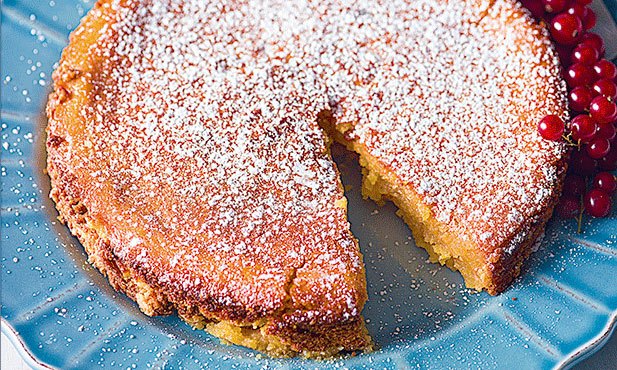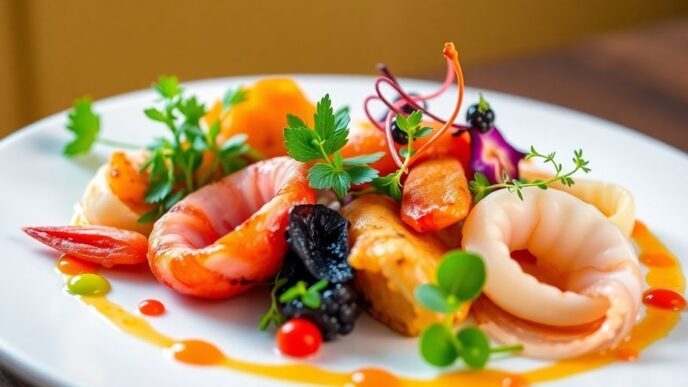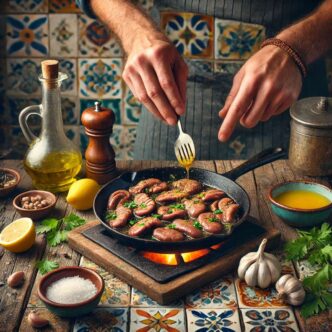Portugal’s rich dessert tradition offers a delightful journey through flavors rooted in centuries-old recipes. From the delicate layers of travesseiros to the almond-infused richness of toucinho do céu and the creamy sweetness of ovos moles, these treats showcase the unique heritage and creative spirit of Portuguese confectionery.
Each dessert carries its own story, blending influences from convent kitchens, regional ingredients, and a passion for sweet indulgence. Discover how these iconic Portuguese sweets capture the essence of Portugal’s culinary past and remain beloved favorites today.
1. Ovos Moles
Ovos Moles, or “soft eggs,” are a delightful Portuguese sweet that originated in the coastal city of Aveiro. These treats are made primarily from egg yolks and sugar, creating a rich and creamy filling. Here are some key points about Ovos Moles:
- Historical Roots: The recipe dates back to the 16th century, created by nuns at the Convento de Jesus in Aveiro. They cleverly used the egg yolks for sweets while the egg whites were used for other purposes.
- Unique Presentation: Ovos Moles are traditionally served in delicate rice-paper wafers shaped like shells, clams, or barrels, reflecting Portugal’s maritime heritage.
- Where to Enjoy: The best place to savor these treats is in Aveiro, where you can find them in many local bakeries. They are also available in Lisbon at Casa dos Ovos Moles.
These sweets are not just a treat; they are a must-try for anyone exploring Portuguese cuisine. Their unique flavor and texture make them a favorite among locals and tourists alike!
2. Travesseiros De Sintra
Travesseiros de Sintra are a must-try when visiting this beautiful region. These delightful pastries are made with flaky dough and filled with a rich mixture of egg cream and almond. Here’s what makes them special:
- Origin: Created during World War II at the famous Piriquita bakery, these pastries have a history that dates back to the discovery of an old recipe by Constança Luísa, the founder’s daughter.
- Texture and Flavor: The pastries are soft and sweet, covered in powdered sugar, making them a treat that you won’t forget. The original filling is a blend of eggs and almonds, but there are now variations like Nutella and apple.
- Cultural Significance: The name “Piriquita” was given by King D. Carlos I, who referred to the short stature of the bakery’s owner. This bakery has been a staple in Sintra since 1862, attracting visitors from all over.

If you find yourself in Sintra, don’t miss the chance to indulge in these delicious travesseiros! They are not just pastries; they are a piece of history and a taste of tradition.
3. Toucinho Do Céu
Toucinho do céu is a delightful Portuguese dessert that has a rich history and a unique flavor. Originating from convents, this sweet treat is made primarily from eggs, sugar, and almonds. Here are some key points about this delicious dessert:
- Ingredients: The main ingredients include eggs, sugar, and almonds, which create a rich and sweet flavor. Some versions also include gila, a type of pumpkin.
- Historical Significance: This dessert was popularized by two orphan girls from the Santa Clara convent in Guimarães, who opened a pastry shop after the convents were closed. Their shop, Casa Costinhas, is still famous for its toucinho do céu today.
- Variations: While there are many versions of toucinho do céu across Portugal, the one from Guimarães is particularly beloved. It is often served in individual portions or larger family sizes.

Toucinho do céu is not just a dessert; it reflects the essence of Portuguese hospitality. When you visit Portugal, trying this sweet is a must!
4. Sericaia
Sericaia is a traditional dessert from the Alentejo region of Portugal. This unique sweet treat is unlike any other in the world. It originated in the convent of Elvas, located east of Évora, the capital of Alentejo. Here are some key points about Sericaia:
- Ingredients: The main ingredients include egg yolks, flour, sugar, and cinnamon. These create a soft texture and a rich flavor that is characteristic of Portuguese convent sweets.
- Serving Style: Sericaia is often served with the delicious Elvas plum, adding a fruity contrast to the creamy dessert.
- Cultural Significance: Enjoying Sericaia is a must when visiting Alentejo, as it is a highlight of the region’s culinary offerings. Not trying it would be a missed opportunity to experience the rich culture of Portugal through its desserts.
This dessert is a true representation of the culinary journey that Portugal offers, blending simple ingredients into a delightful experience that reflects the country’s history and traditions.
5. Pastéis De Tentúgal
Pastéis de Tentúgal are a delightful treat from Portugal, known for their incredibly thin pastry. Here’s what makes them special:
1. Unique Texture
- The pastry is stretched by hand to be extremely thin, measuring only 0.06 to 0.15 mm.
- This delicate texture makes them crispy and light, a perfect contrast to the rich filling.
2. Sweet Filling
- The inside is filled with a sweet egg cream, known as doce de ovos, which adds a rich flavor.
- This combination of crispy pastry and sweet filling creates a delightful experience for your taste buds.
3. Historical Significance
- These pastries originated from the Convento Nossa Senhora da Natividade in the 16th century.
- They were once considered a remedy for weakness, showcasing their long-standing cultural importance.
4. Protected Status
- Pastéis de Tentúgal have been granted Protected Geographical Indication, meaning they can only be made in a specific area.
- This ensures that you are tasting an authentic version when you try them in Tentúgal or select bakeries.
5. Where to Enjoy
- The best place to try these pastries is at Pastelaria Pousadinha in Tentúgal.
- If you can’t make it there, you can find them in various bakeries in Coimbra, ensuring you don’t miss out on this delicious treat!
6. Pudim Abade De Priscos
Pudim Abade de Priscos is a delightful dessert that hails from the city of Braga, Portugal. This pudding is not just any sweet; it has a rich history and a unique flavor that makes it stand out. Here’s what you need to know about this traditional treat:
- Ingredients: The pudding is made with a few key ingredients, including Port wine, thinly sliced bacon, and sugar. The combination of these ingredients creates a rich and creamy texture that melts in your mouth.
- Historical Significance: This dessert was popularized by a priest who shared his recipe with students at a local school. It has since become a beloved dish in Portuguese cuisine, showcasing the culinary heritage of the region.
- Texture and Taste: The ideal Pudim Abade de Priscos should have a delicate, gelatinous consistency. When you take a bite, it should feel like it just dissolves in your mouth, offering a sweet and savory experience that is truly unique.
This pudding is a testament to the rich flavors of Portuguese cuisine, and it’s a must-try for anyone looking to explore traditional sweets from Portugal. Whether enjoyed at a local bakery or made at home, Pudim Abade de Priscos is sure to impress with its delicious taste and fascinating background.
7. Pastéis De Santa Clara
Pastéis de Santa Clara are a delightful treat from Coimbra, Portugal. These pastries are known for their delicate texture and sweet filling. Here’s what makes them special:
- Origin: Created by the nuns of the Clarissa Monastery, these pastries have a rich history dating back to the 19th century.
- Ingredients: The filling is made from a mix of egg yolks and almonds, giving it a unique flavor.
- Shape: They are often shaped like stars or hearts, making them visually appealing as well as tasty.
These pastries were once sold at the monastery and are now available in many bakeries in Coimbra. They are a must-try for anyone visiting the area!
8. Dom Rodrigo
Dom Rodrigo is a delightful Portuguese dessert that has its roots in the Algarve region. This sweet treat has been enjoyed since the 18th century and is known for its unique combination of flavors and textures. Here’s what makes Dom Rodrigo special:
- Main Ingredients: The dessert is primarily made from egg yolks, sugar, and ground almonds. These ingredients come together to create a rich and creamy filling.
- Preparation: The filling is wrapped in a thin layer of wafer, which is then shaped into a roll. This gives Dom Rodrigo its distinctive appearance.
- Serving: It is often dusted with powdered sugar and can be served chilled or at room temperature, making it a versatile dessert for any occasion.
Dom Rodrigo is not just a treat; it’s a piece of culinary history that reflects the rich traditions of Portuguese sweets. If you ever find yourself in the Algarve, be sure to try this delicious dessert!
9. Figos Cheios
Figos Cheios are a delightful traditional sweet from Olhão, often enjoyed by fishermen during their long days at sea. These treats are not just tasty; they are also packed with energy, making them perfect for a quick snack. Here’s what makes Figos Cheios special:
- Ingredients: The main components include flattened figs, peeled almonds, sugar, fennel, chocolate, cinnamon, and lemon. This combination creates a rich flavor that is both sweet and slightly tangy.
- Preparation: The figs are layered with the other ingredients, creating a delicious and nutritious bar-like treat. This method of preparation ensures that each bite is bursting with flavor.
- Cultural Significance: Historically, these sweets were a staple for fishermen, providing them with the energy needed for their demanding work. Today, they are enjoyed by many and are a symbol of the region’s culinary heritage.
Figos Cheios are a wonderful example of how traditional recipes can offer both taste and history. If you ever find yourself in Olhão, be sure to try this unique sweet!
10. Morgadinhos
Morgadinhos are a delightful Portuguese sweet that originated in Portimão and Silves. These treats are made with a mix of ingredients that create a unique flavor. Here’s what you need to know about them:
- Ingredients: The main components include sugar, water, peeled and ground almonds, and egg yolks. The filling typically consists of chila (a type of pumpkin) and threads of egg.
- Decoration: After baking, the morgadinhos are covered with a sweet glaze. The larger versions are often adorned with petals, while the smaller ones are decorated with silver balls.
- Where to Find Them: You can find amazing versions of morgadinhos at Doce Fino pastry shop in Faro, known for their traditional recipes and quality ingredients.
These sweets are not just a treat; they represent a piece of Portuguese culture and history, making them a must-try for anyone visiting the region!
Frequently Asked Questions
What are Ovos Moles?
Ovos Moles are a famous Portuguese sweet made mainly from egg yolks and sugar. They are often enjoyed on their own or wrapped in a thin wafer shell shaped like a shell or fish.
Where can I find the best Travesseiros de Sintra?
The best Travesseiros de Sintra can be found at A Piriquita bakery in Sintra, which has been serving these delicious pastries since 1862.
What is Sericaia and where is it from?
Sericaia is a traditional dessert from the Alentejo region of Portugal. It is a soft pudding made with egg yolks, flour, sugar, and cinnamon.
What are Pastéis de Tentúgal?
Pastéis de Tentúgal are thin, crispy pastries filled with a sweet egg mixture. They are known for their delicate texture and are a protected specialty from the Tentúgal area.
What is Toucinho do Céu?
Toucinho do Céu, meaning ‘bacon from heaven,’ is a rich almond cake traditionally made with eggs, sugar, and lard. It has a unique flavor and is often found in various regions of Portugal.
Where can I try Pudim Abade de Priscos?
Pudim Abade de Priscos is a famous pudding from Braga, typically made with Porto wine and thinly sliced bacon. You can find it in local bakeries and restaurants in Braga.











